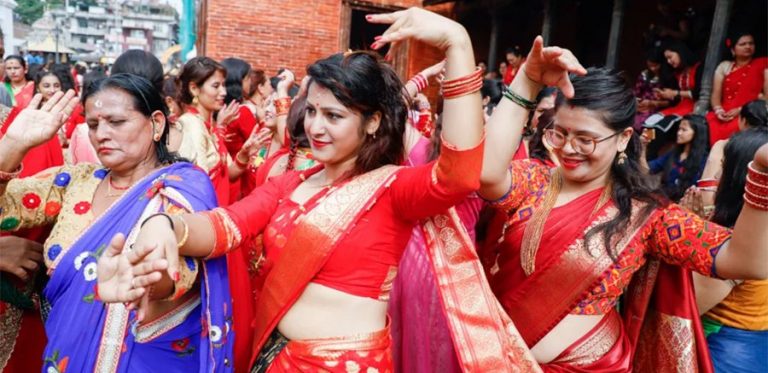
HaritalikaTeej Festival is a Nepali Hindu women’s sacred festival celebrated with pleasure and optimism. Teej is a festival devoted to Lord Shiva and Parvati, also known as HaritalikaTeej. It is a three-day celebration during which ladies fast in the name of Lord Shiva in order for their spouse to have a long and happy life.Teej is also known in Nepal as a women’s festival. Teej is celebrated by both married and single ladies. The event began as a holy holiday for Brahmin and Kshetriya caste women, but it has now expanded to include ladies from various ethnic groups.
On this auspicious day, Lord Shiva devotees gather to adore Lord Shiva and Parvati. According to the Nepali lunar calendar, Nepali ladies celebrate Teej on the third day of BhadraShukla.The festival takes place in late August and early September, according to the English calendar. Teej falls during the monsoon season, which means there is a good chance of rain.
At Pashupatinath temple, a revered shrine for Lord Shiva’s devotees, a large gathering can be seen. Women dresses in particular dress in red and dance to folk music, which lends a twist to conventional ideals.On this day, women wear bangles, tikas, and a variety of other jewelry. Continue reading to discover about the significance of the color red and the Teej rituals.Teej is a unique Nepali women’s celebration. The day has been proclaimed a public holiday so that ladies can fully enjoy the festivities of Teej. This Hindu festival is supposed to take place during the SatyaYug, or the Age of Gods, according to Hindu mythology.
Sati, the beautiful daughter of Prajapati Daksha and Prastuti, fell in love with Lord Shiva and desired to marry him. Her father, however, being a King, desired that his daughter marry a King.Lord Shiva was represented as a tiger with a serpent around his neck. He would constantly meditate and carry a ‘Damaru’. To Sati’s father, Lord Shiva seemed to be a beggar. As a result, the King rejected Sati’s wish to marry Lord Shiva and instead arranged for her to marry a wealthy king. Sati jumped into the flames after being denied. Lord Shiva was heartbroken over the loss of his true love. Sati later reborn as Parvati and was married to King Himalaya. Parvati prayed and fasted in order to re-unite with Lord Shiva. Finally, Lord Shiva was taken aback by her resolve and honesty. He took Parvati as his wife after realizing she was his genuine love. Finally, Lord Shiva was taken aback by her resolve and honesty. He took Parvati as his wife after realizing she was his genuine love.The Hindu faith places a high value on this legend. Teej commemorates the reunification of Lord Shiva and Parvati. It is a celebration of real love and relationships. The blessing of Lord Shiva and Parvati is said to boost our love and marriage.
Ladies fast on Teej and worship Lord Shiva in the hopes of finding a husband like Lord Shiva himself and married women finding their husbands to live a long and happy life. Teej has religious significance since it symbolizes Lord Shiva and Parvati’s reunion. On Teej, a married lady worships her spouse as God and, after a long fast, takes the first bite of food and drinks the first drop of water from their husband’s hand. For blessings, they bend down at their husband’s feet.
Women are clothed in bright traditional clothing and accessorized with heavy antique jewelry to resemble brides. Women assemble their female relatives, friends, and neighbors to consume the feast. Then they sing and dance their way through the event. They also give each other presents to demonstrate their love and care.
Women assemble for a big feast the night before the fasting day. Dar Khane din is the name given to this day. They make a variety of foods with a variety of flavors and spices. Dar is the name of the feast. They keep themselves entertained by singing and dancing to Teej tunes. They even give each other presents. Such a gesture deepens their relationship and demonstrates their concern for one another. With the advancement of civilization, women’s celebrations of Dar Khane Din have evolved as well. The second day of Haritalika Teej, when ladies fast, falls on the third day of Bhadra’s full moon day. They take a bath in the morning after waking up early. With Nepal, it is customary for married women to dress up in a red saree, pote, bangles, tika, and sindoor.Unmarried women dress colorfully as well, but without the sindoor and pote. Sindoor and pote denote a lady who is married.
Most women go to Pashupatinath Temple in Gaushala, which is Nepal’s largest Shiva temple. Those who are unable to go to Pashupatinath Temple visit adjacent minor Shiva temples with equal passion and belief.They sing and dance at Pashupatinath’s site after worshiping Lord Shiva. Women standing in line for hours and then singing and dancing without a drop of drink is a sight to behold. Women sing and dance so joyfully and confidently that they forget they are fasting.
Moreover, Teej Celebration is a great festival in Nepal for Nepali women, commemorating the union of Lord Shiva and Parvati. The event has religious importance for them since they pray to Lord Shiva for their husband’s and married life’s success. It is the greatest time for visitors to Nepal to learn about the country’s history and culture. If this article has piqued your interest and you’d want to join in the Teej celebrations in Nepal, you may do so during the holiday season in August/September.
-Article written by: Saru Niraula for Land Nepal